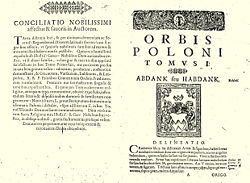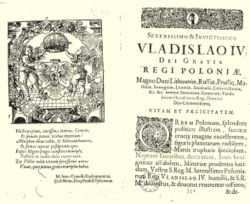
Szymon Okolski
Encyclopedia

Polish-Lithuanian Commonwealth
The Polish–Lithuanian Commonwealth was a dualistic state of Poland and Lithuania ruled by a common monarch. It was the largest and one of the most populous countries of 16th- and 17th‑century Europe with some and a multi-ethnic population of 11 million at its peak in the early 17th century...
historian, theologian, and specialist in heraldry
Heraldry
Heraldry is the profession, study, or art of creating, granting, and blazoning arms and ruling on questions of rank or protocol, as exercised by an officer of arms. Heraldry comes from Anglo-Norman herald, from the Germanic compound harja-waldaz, "army commander"...
. His own clan and coat of arms were that of Rawicz. Born in Kamieniec Podolski, died in Lviv
Lviv
Lviv is a city in western Ukraine. The city is regarded as one of the main cultural centres of today's Ukraine and historically has also been a major Polish and Jewish cultural center, as Poles and Jews were the two main ethnicities of the city until the outbreak of World War II and the following...
. He headed chairs of theology in Lviv
Lviv
Lviv is a city in western Ukraine. The city is regarded as one of the main cultural centres of today's Ukraine and historically has also been a major Polish and Jewish cultural center, as Poles and Jews were the two main ethnicities of the city until the outbreak of World War II and the following...
and Bologna
Bologna
Bologna is the capital city of Emilia-Romagna, in the Po Valley of Northern Italy. The city lies between the Po River and the Apennine Mountains, more specifically, between the Reno River and the Savena River. Bologna is a lively and cosmopolitan Italian college city, with spectacular history,...
. A member of the Dominican Order
Dominican Order
The Order of Preachers , after the 15th century more commonly known as the Dominican Order or Dominicans, is a Catholic religious order founded by Saint Dominic and approved by Pope Honorius III on 22 December 1216 in France...
, in 1641 he became a superior of the Dominican monastery in Kamieniec Podolski. In 1648 Okolski accepted the post of the prowincjał (province leader) of the Dominican Order in the Polish-Lithuanian Commonwealth
Polish-Lithuanian Commonwealth
The Polish–Lithuanian Commonwealth was a dualistic state of Poland and Lithuania ruled by a common monarch. It was the largest and one of the most populous countries of 16th- and 17th‑century Europe with some and a multi-ethnic population of 11 million at its peak in the early 17th century...
-controlled Ruś
Rus
Ruś may refer to the following places:*Ruś, Podlaskie Voivodeship, a village in Łomża County, north-eastern Poland*Ruś, Olsztyn County, a village in Warmian-Masurian Voivodeship, northern Poland...
territories. The center of the province was located in Lviv.
In 1637-38 Okolski accompanied Crown hetman
Hetman
Hetman was the title of the second-highest military commander in 15th- to 18th-century Poland and the Grand Duchy of Lithuania, which together, from 1569 to 1795, comprised the Polish-Lithuanian Commonwealth, or Rzeczpospolita....
Mikołaj Potocki during his neutralization of rebellious Cossacks driven by Jakub Ostrzanin and Dmytro Hunia
Dmytro Hunia
Dmytro Hunia was elected hetman of the Zaporozhian Host in 1638. He was one of the leaders of the Ostrzanin Uprising, a 1638 Cossack uprising against the Polish-Lithuanian Commonwealth. The rebellion was sparked by the Sejm act of the same year that declared that non-Registered Cossacks are equal...
. Being a witness and a direct participant of those developments, Okolski gave a detailed description of them in his field diaries. The latter were published immediately and became a valuable source of information for historians and writers: for instance, Nikolai Gogol
Nikolai Gogol
Nikolai Vasilievich Gogol was a Ukrainian-born Russian dramatist and novelist.Considered by his contemporaries one of the preeminent figures of the natural school of Russian literary realism, later critics have found in Gogol's work a fundamentally romantic sensibility, with strains of Surrealism...
must have used these materials for his "Taras Bulba" - a novel devoted to the Cossack rebellions 1637-38. Okolski is an author of historical and heraldic books among which an armorial of Polish nobility “Orbis Polonus” (1641–1643) is the most famous one. Languages of his works are Polish and Latin.
Published works

- Orbis Polonus splendoribus coeli, triumphis mundi, pulchritudine animantium condecoratus, in quo antiqua Sarmatorum gentiliata pervetusta nobilitatis insignia etc. specificantur et relucent (V. 1-3, Kraków, 1641–43) - the armorial of Polish nobility;
- "Dyaryusz transactiey wojennej między wojskiem koronnem i zaporoskiem w r. 1637 miesiąca Grudnia przez Mikołaja Potockiego zaczętej i dokończonej», (Zamość, 1638) - field diary concerning the 1637 Cossack rebellion;
- Kontynuacya dyaryusza wojennego etc. (Kraków, 1639) - continuation of Okolski's field notes of the Cossacks neutralization. In 1738 both diaries were translated to Russian by Stephan Lukomski, a historian;
- Russia Florida etc. (Lwów, 1646; 7th edition - Leipzig, 1759) – history of the Dominican Order in Russia, with general data on population, regions, Russian monasteries, etc.;
- Kioviensium et Czernichoviensium episcoporum etc. ordo et numeris descriptus (Lwów, 1646 ; Polish translation by ks. Serwatowski, Kraków, 1853);
- Żywoty niektórych św. zakonnic dominikanek (cz. I, Kraków 1638; cz. II Niebo ziemskie Anjolów w ciele palma i lilija ozdobione etc. (Lwow 1644).
There are also some Okolski's unpublished manuscripts («Miscellanea») kept in the Dominican monastery in Lvov.

